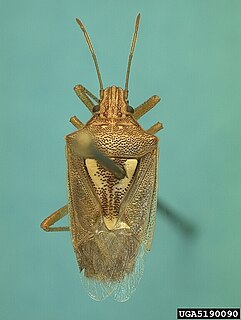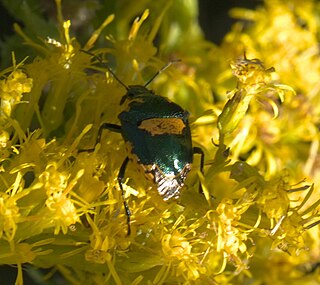
The Pentatomoidea are a superfamily of insects in the Heteroptera suborder of the Hemiptera order. As Hemiptera, they share a common arrangement of sucking mouthparts. The roughly 7000 species under Pentatomoidea are divided into 21 families. Among these are the shield bugs, giant shield bugs, burrower bugs, and stink bugs.

Pentatomidae is a family of insects belonging to the order Hemiptera, generally called shield bugs or stink bugs. Pentatomidae is the largest family in the superfamily Pentatomoidea, and contains around 900 genera and over 4700 species. As hemipterans, the pentatomids have piercing sucking mouthparts, and most are phytophagous, including several species which are severe pests on agricultural crops. However, some species, particularly in the subfamily Asopinae, are predatory and may be considered beneficial.

The brown marmorated stink bug is an insect in the family Pentatomidae, native to China, Japan, Korea and other Asian regions. In September 1998 it was collected in Allentown, Pennsylvania, where it is believed to have been accidentally introduced. The nymphs and adults of the brown marmorated stink bug feed on over 100 species of plants, including many agricultural crops, and by 2010–11 had become a season-long pest in orchards in the Eastern United States. In 2010, in the Mid-Atlantic United States, $37 million in apple crops were lost, and some stone fruit growers lost more than 90% of their crops. It is now established in many parts of North America, and has recently become established in Europe and South America.

Tessaratomidae is a family of true bugs. It contains about 240 species of large bugs divided into 3 subfamilies and 56 genera.

The Dinidoridae are a small family of insects comprising about a hundred species in sixteen genera in the Hemipteran suborder Heteroptera, the "true bugs". As a group the family does not have any common name. Until the late 19th century they were generally regarded as a subfamily of the Pentatomidae.

Perillus is a genus of predatory stink bugs in the family Pentatomidae. There are about seven described species in Perillus.
Vulsirea nigrorubra is a species of stink bug in the family Pentatomidae. It is found in the Caribbean.

Mormidea lugens is a species of stink bug in the family Pentatomidae found in the Caribbean, Central America, and Eastern North America. In Illinois, adults have been observed emerging from overwintering sites in late April, and continue to be observed until early November, and appear to be bivoltine in this area. Eggs are approximately 0.7 millimetres (0.028 in) in diameter, pale yellow, and laid in small clusters of 6 to 11 eggs. Adults are bronze in color, with a white-yellow border around the scutellum, and are 5.0–7.2 millimetres (0.20–0.28 in) in length. In laboratory conditions, at approximately 24 °C (75 °F), development from eggs to adults has been documented to take between 39 and 50 days, and appears to be affected by the species of host plant. Mormidea lugens has been documented to feed on timothy, sedges, as well as deer-tongue grass, and Bosc's panic-grass. It has been collected from pale sedge and wide-leaved spiderwort but has not observed feeding on these species, and deer-tongue grass appears to be an insufficient food source for development.
Sciocoris longifrons is a species of stink bug in the family Pentatomidae. It is found in North America.

Mormidea is a genus of stink bugs in the family Pentatomidae. There are about five described species in Mormidea.
Vulsirea is a genus of stink bugs in the family Pentatomidae. There are at least two described species in Vulsirea.
Banasa lenticularis is a species of stink bug in the family Pentatomidae. It is found in the Caribbean, Central America, North America, and South America.

Chlorocoris hebetatus is a species of stink bug in the family Pentatomidae. It is found in Central America and North America.

Oebalus ypsilongriseus is a species of stink bug in the family Pentatomidae.

Oebalus is a genus of stink bugs in the family Pentatomidae. There are about six described species in Oebalus.

Mecideini is a tribe of stink bugs in the family Pentatomidae. There is at least one genus, Mecidea, in Mecideini.

Stiretrus anchorago, commonly known as the anchor stink bug, is a species of predatory stink bug in the family Pentatomidae. It is found in Central America and North America. It is known to prey upon Epiachnia varivestis and Hypera postica.

Cyclopelta is a genus of Dinidorid bug found in Africa and Asia. There are 14 species in the genus with 8 found in Asia and 6 in Africa. Some species are known to form large aggregation on trees and can cause damage in a few trees of economic importance.
Megarididae is a family of true bugs in the superfamily Pentatomoidea. The family consists of a single extant genus Megaris with about 16 species restricted to the Neotropical Realm and a fossil is known from Dominican amber.

Gynenica is a genus of stink bug with about fourteen species in the Afrotropical and Oriental regions. It is one of four genera placed in the tribe Lestonocorini along with Lestonocoris, Neogynenica, and Umgababa that occur in Africa and India and feed on plants in the family Acanthaceae. Bugs in the genus have the pronotum tips extended into forward and upward curving spines. The scutellum is longer than broad, the apex with a rounded point and not reaching beyond the middle of the abdomen.













